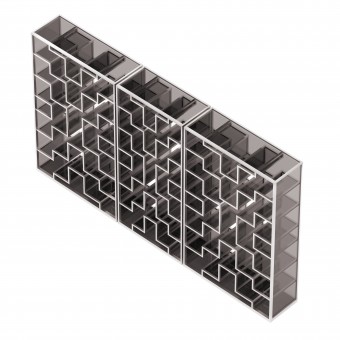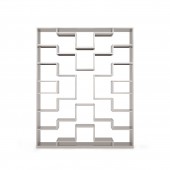Literis Lux Bookshelf by Eckhard Beger |
Home > Winners > #57409 |
 |
|
||||
| DESIGN DETAILS | |||||
| DESIGN NAME: Literis Lux PRIMARY FUNCTION: Bookshelf INSPIRATION: The basic idea in designing Literis Lux was to create a bookshelf suited for diverse book and document sizes in which the horizontal shelves and vertical dividers are inspired by stair shaped geometric ornamentations. UNIQUE PROPERTIES / PROJECT DESCRIPTION: Literis Lux by Eckhard Beger for ArteNemus is a family of bookshelves designed to accommodate books with a large variety of sizes (from 20cm to 60cm) as well as magazines and larges drawings (in the highest and lowest compartments). The shelves and dividers follow a stair shaped graphic pattern. The contemporary appearance of Literis Lux is underlined by the satinated stainless steel structure and the smoked glass panels. When combining 2 or 3 units the ornamental pattern is continued and emphasized. OPERATION / FLOW / INTERACTION: We probably all own books of largely diverse dimensions (from less than 16cm to more than 45cm of height). We also have large prints, which are currently unused and sometimes end up on the top of or behind a cupboard gathering dust. The bookshelf Literis Lux is designed to store books of diverse dimensions (20cm to 60cm), magazines and at the same time to protect large prints or posters (rolls of 100cm). Literis Lux is conceived in 3 widths for rooms of diverse sizes. Different units can be combined. PROJECT DURATION AND LOCATION: The project was started in Geneva in June 2016 en ended in the same place in October of the same year. FITS BEST INTO CATEGORY: Furniture Design |
PRODUCTION / REALIZATION TECHNOLOGY: The structure of Literis Lux is made from satinated, welded rectangular stainless steel tubes. The horizontal and vertical glass panels are made from smocked glass panels inserted into the steel structure. SPECIFICATIONS / TECHNICAL PROPERTIES: Literis Lux is proposed in three different width to accommodate rooms of different sizes Dimensions W x H x D: 161/124/94 x 202 x 35 cm TAGS: Literis Lux, ArteNemus, Eckhard Beger, Bookshelf RESEARCH ABSTRACT: The spacing of the shelves was chosen based on an analysis of the book collection of the city library. Based on a statistical approach these helped to determine height and width of the individual compartments. CHALLENGE: The main issue during the design process was to put the functional requirements (defining shelf distances corresponding to real books) and the aesthetic requirements (having an aesthetically attractive front) in line. ADDED DATE: 2017-04-02 19:16:41 TEAM MEMBERS (1) : Eckhard Beger IMAGE CREDITS: Eckhard Beger |
||||
| Visit the following page to learn more: http://bit.ly/2oy2qre | |||||
| AWARD DETAILS | |
 |
Literis Lux Bookshelf by Eckhard Beger is Winner in Furniture Design Category, 2016 - 2017.· Read the interview with designer Eckhard Beger for design Literis Lux here.· Press Members: Login or Register to request an exclusive interview with Eckhard Beger. · Click here to register inorder to view the profile and other works by Eckhard Beger. |
| SOCIAL |
| + Add to Likes / Favorites | Send to My Email | Comment | Testimonials | View Press-Release | Press Kit |
Did you like Eckhard Beger's Furniture Design?
You will most likely enjoy other award winning furniture design as well.
Click here to view more Award Winning Furniture Design.








